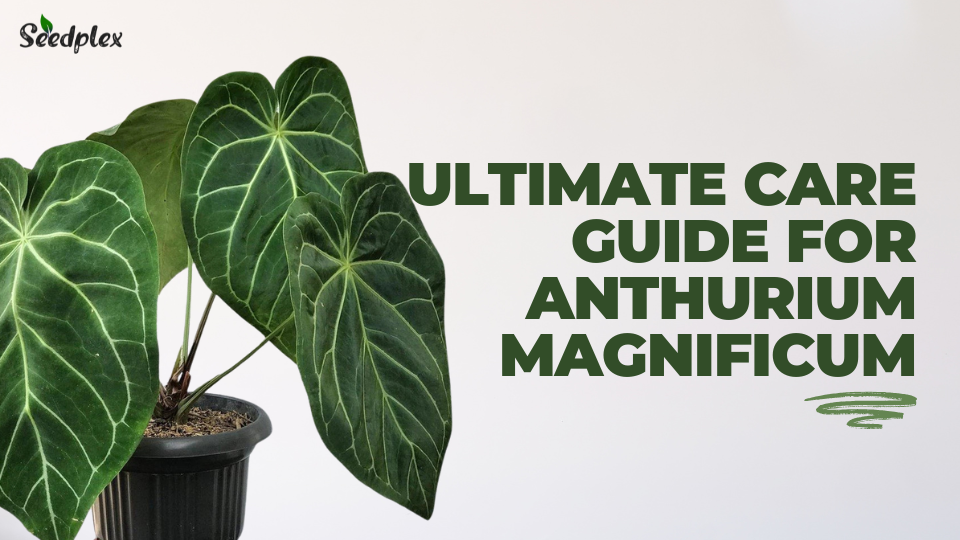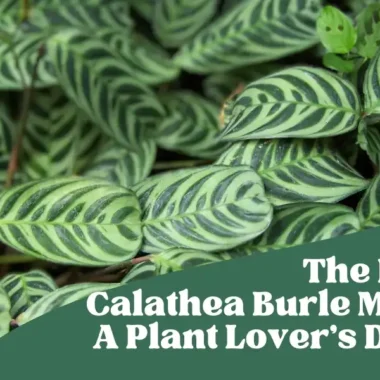Anthurium Magnificum, commonly known as the Velvet-leaf Anthurium, is a stunning tropical plant beloved by houseplant enthusiasts for its striking foliage. This plant, native to the cloud forests of South America, particularly Colombia, is known for its large, dark green leaves with prominent white or pale green veins, which give it a velvety appearance. With its dramatic and lush foliage, the Anthurium Magnificum makes a statement in any indoor space. However, due to its specific care needs, it can require more attention than other common houseplants. In this guide, we’ll walk you through everything you need to know about Anthurium Magnificum care, from optimal lighting and watering practices to temperature and humidity control.
1. Lighting Needs for Anthurium Magnificum
The first key to success in growing Anthurium Magnificum is understanding its light requirements. As a tropical plant native to rainforests, it thrives in conditions with filtered, bright, indirect light. In its natural environment, the Anthurium Magnificum grows beneath the canopy of larger trees, where it receives dappled sunlight.
Optimal Light Conditions
- Indirect Light: The plant thrives best when placed in areas with bright, indirect light. Direct sunlight, especially through windows facing south or west, can scorch its soft, velvety leaves. The intense rays will lead to unsightly brown patches and can harm the overall health of the plant.
- Filtered Light: To mimic its natural environment, place the Anthurium Magnificum near an east or north-facing window, where the light is soft and filtered. If only south or west-facing windows are available, consider using sheer curtains to diffuse the light and protect the plant from direct exposure.
- Low Light: While the plant can tolerate lower light conditions, it won’t grow optimally in low light. Reduced light can lead to slow growth, smaller leaves, and a lack of vibrant coloration. If your space doesn’t get enough natural light, consider supplementing with grow lights.
Signs of Improper Lighting
- Too much light: Leaves that turn yellow, crispy, or brown at the edges, especially on the tips or in the center, may be signs of sunburn.
- Too little light: The plant’s growth will slow, and the leaves may become smaller. In extreme cases, the plant may become leggy with long spaces between leaves.
2. Watering Anthurium Magnificum
Watering is a crucial aspect of Anthurium Magnificum care. The plant likes to stay moist, but not soggy, and is highly sensitive to overwatering. Improper watering practices can lead to root rot, which can kill the plant.
Watering Frequency
- Check the Soil Moisture: Water the Anthurium Magnificum when the top 1-2 inches of soil are dry to the touch. Typically, this means you should water once a week during the growing season (spring and summer). During the dormant period (fall and winter), reduce watering to once every two weeks, depending on the humidity and temperature of your environment.
- Consistent Moisture: The plant does not like to be left in dry soil for extended periods. However, avoid letting the soil stay soggy for too long, as this can promote root rot.
- Watering Method: Always water the plant thoroughly until excess water drains from the bottom of the pot. This ensures that the moisture reaches the root system, promoting healthy growth. Be sure to empty any water that collects in the saucer beneath the pot, as stagnant water can lead to root rot.
Water Quality
- Use Filtered or Distilled Water: Anthurium Magnificum is sensitive to chemicals such as chlorine and fluoride, which are often present in tap water. These chemicals can cause yellowing of the leaves or other signs of distress. Use distilled, filtered, or rainwater for the best results.
Signs of Overwatering and Underwatering
- Overwatering: Yellowing leaves, wilting, and mushy stems are signs of overwatering. If the plant has a musty smell or if the soil feels constantly soggy, it’s an indication that the roots are waterlogged.
- Underwatering: Wilting leaves, crispy or dry edges, and yellowing can also be signs of underwatering. Ensure you are watering the plant enough to keep the soil consistently moist but not overly wet.
3. Humidity Requirements for Anthurium Magnificum
As a tropical plant, Anthurium Magnificum thrives in high humidity levels. The average indoor environment may be too dry, especially in colder months when indoor heating systems can lower the humidity levels significantly.
Ideal Humidity Levels
- High Humidity (60-80%): To mimic its native environment, Anthurium Magnificum thrives in humidity levels between 60% and 80%. In lower humidity, the plant may start to show signs of stress, such as browning leaf edges or leaf curl.
- Maintaining Humidity: If your home has dry air, especially in winter, it’s essential to find ways to increase humidity around your Anthurium Magnificum.
- Humidifiers: The most effective method for maintaining high humidity is using a room humidifier. Place the humidifier near the plant to help maintain optimal humidity levels.
- Misting: Lightly misting the plant with water can help raise the humidity levels around it. However, be cautious of over-misting, which can lead to fungal growth or mildew.
- Humidity Trays: Place a shallow tray filled with water and pebbles under the plant. As the water evaporates, it increases the humidity around the plant.
Signs of Low Humidity
- Brown, crispy edges on the leaves or curling of the leaf margins are indicators of insufficient humidity. A drop in leaf size and slower growth may also occur in very dry conditions.
4. Temperature Needs for Anthurium Magnificum
Temperature plays a crucial role in the overall health of Anthurium Magnificum. The plant prefers warm, consistent temperatures and is sensitive to sudden changes.
Optimal Temperature Range
- Ideal Range: The ideal temperature for Anthurium Magnificum is between 65°F to 80°F (18°C to 27°C). These temperatures mimic the plant’s natural tropical habitat and promote vigorous growth.
- Cold Sensitivity: Anthurium Magnificum does not tolerate cold temperatures. Temperatures below 60°F (15°C) can cause the plant to go into shock and stunt growth. Prolonged exposure to temperatures below this range can lead to leaf damage or even plant death.
Temperature Fluctuations
- Avoid Drafts: Keep the plant away from drafts, air conditioners, and heaters, as sudden temperature changes can stress the plant and slow down its growth.
5. Soil Requirements for Anthurium Magnificum
Soil quality is an essential factor in Anthurium Magnificum care. The plant thrives in well-draining, slightly acidic soil that retains some moisture without becoming waterlogged.
Ideal Soil Mix
- Well-Draining Soil: A mix that combines moisture retention with good drainage is ideal. Consider a mixture of:
- Peat moss or coconut coir for moisture retention.
- Perlite or pine bark for drainage and aeration.
- Orchid bark can be added to improve texture and promote airflow around the roots.
- pH Level: Anthurium Magnificum prefers slightly acidic soil, with a pH range between 5.5 and 6.5.
Repotting
- When to Repot: Repot the plant every 1-2 years, or when the roots have outgrown the pot. During repotting, ensure that the new pot has good drainage and is one size larger than the current one. Be cautious not to disturb the root ball too much.
6. Fertilizing Anthurium Magnificum
Fertilizing is essential for encouraging growth and ensuring that your Anthurium Magnificum gets the nutrients it needs to thrive.
Fertilizer Type
- Balanced Fertilizer: Use a balanced, water-soluble fertilizer (such as a 20-20-20 formula) diluted to half-strength. Fertilizers designed for houseplants or tropical plants will work well.
- Slow-Release Fertilizer: You can also use slow-release fertilizer granules to feed your plant over time. These can be added to the soil during repotting.
Fertilizing Frequency
- Growing Season: During the growing season (spring and summer), fertilize every 4-6 weeks. Over-fertilizing can cause nutrient burn, so it’s essential to follow the recommended dosage.
- Winter: In the dormant months (fall and winter), reduce fertilization or skip it entirely, as the plant is not actively growing during this time.
7. Pruning and Maintenance
Pruning and regular maintenance help keep Anthurium Magnificum looking its best. Pruning encourages healthier growth and can prevent disease.
Pruning Dead or Damaged Leaves
- Remove Damaged Foliage: Use clean, sharp scissors or pruning shears to remove yellow, brown, or damaged leaves. This will not only improve the plant’s appearance but also prevent the spread of disease.
Cleaning the Leaves
- Wipe Dust and Debris: Wipe the large, velvety leaves gently with a damp cloth to remove dust and dirt. Dust can block the plant’s ability to absorb light, which can hinder its growth.
Managing Aerial Roots
- Trim Excess Roots: The plant will naturally produce aerial roots as it grows. These roots are essential for anchoring the plant and absorbing nutrients. If they become excessively long or unsightly, you can trim them carefully.
8. Common Pests and Problems
While Anthurium Magnificum is relatively pest-resistant, it’s still susceptible to a few common houseplant pests and issues.
Common Pests
- Spider Mites: Tiny, red or yellowish bugs that can cause speckled damage to leaves.
- Mealybugs: Cotton-like pests that cluster on the leaf joints and stems.
- Scale Insects: Small, flat insects that attach themselves to stems and leaves.
Treatment
- Insecticidal Soap: If you notice pests, treat the plant with insecticidal soap or a mixture of water and dish soap. Neem oil is also effective at controlling a variety of pests.
- Check Regularly: Regularly inspect the plant for signs of pests and remove them immediately.
Frequently Asked Questions
1. Why are the leaves of my Anthurium Magnificum turning yellow?
Yellowing leaves can be caused by several factors, including overwatering, low humidity, or exposure to too much direct sunlight. Check the plant’s watering schedule, humidity levels, and lighting conditions to ensure they are optimal.
2. Can I grow Anthurium Magnificum outdoors?
While the plant thrives in tropical climates, it’s best to grow Anthurium Magnificum indoors in most locations, especially where the temperature regularly drops below 60°F (15°C).
3. How often should I repot my Anthurium Magnificum?
Repot the plant every 1-2 years or when you notice that the roots are becoming cramped in the pot. Be careful not to disturb the roots too much during repotting.
4. What should I do if the leaves of my plant start curling?
Curling leaves can be a sign of low humidity or underwatering. Increase humidity by using a humidifier, misting the plant, or placing it on a humidity tray.
5. Why is my Anthurium Magnificum not growing?
Lack of growth may be due to inadequate lighting, nutrient deficiencies, or incorrect watering. Make sure the plant receives bright, indirect light, is watered properly, and is fertilized during the growing season.
6. Can I cut back the aerial roots of my Anthurium Magnificum?
Yes, you can trim excessive aerial roots, but be careful not to damage the plant’s main stem or root system.
7. Is Anthurium Magnificum toxic to pets?
Yes, like other members of the Anthurium family, Anthurium Magnificum is toxic to both cats and dogs if ingested. Keep the plant out of reach of pets.
8. How can I tell if my Anthurium Magnificum is getting enough light?
If the plant’s leaves are large and healthy with a vibrant green color and the veins are clearly visible, it’s getting enough light. If the leaves are small, yellow, or pale, it may need more light.







